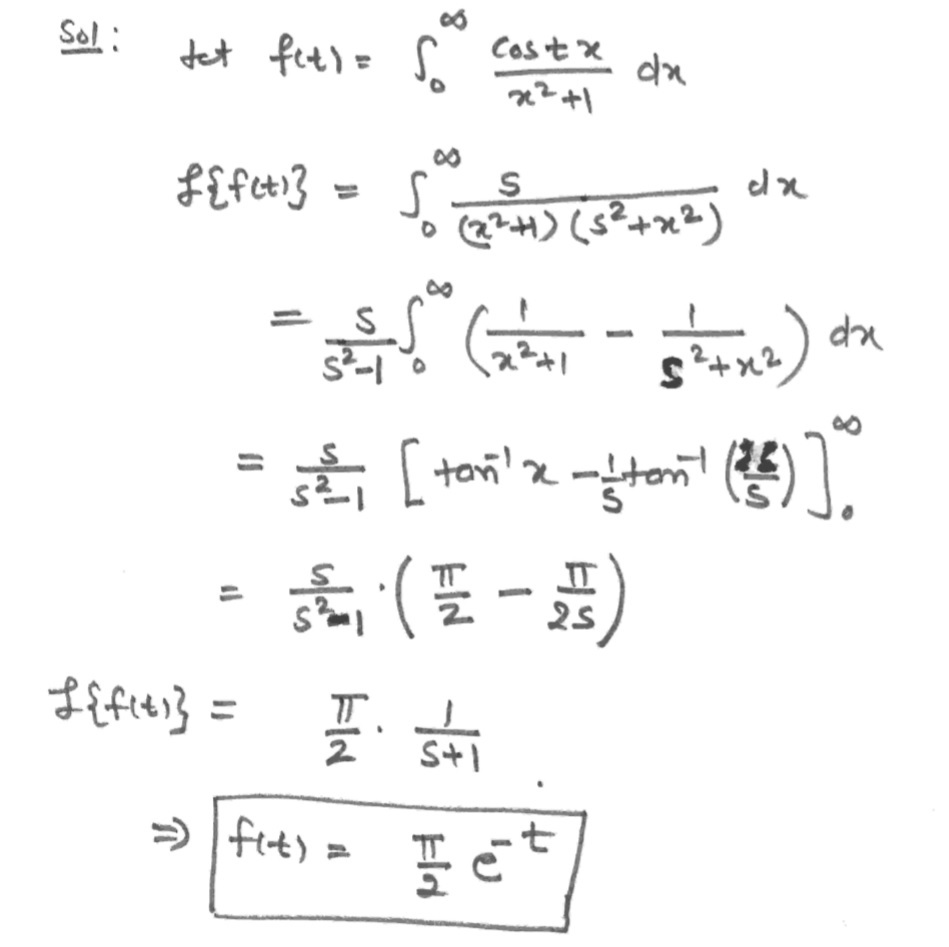Integration is back
Find ∫ 0 ∞ x 2 + 1 cos ( t x ) d x at t = ln ( 8 π ) .
If this integral can be expressed as A × π B for rationals A and B , find A × B .
The answer is 0.125.
This section requires Javascript.
You are seeing this because something didn't load right. We suggest you, (a) try
refreshing the page, (b) enabling javascript if it is disabled on your browser and,
finally, (c)
loading the
non-javascript version of this page
. We're sorry about the hassle.
3 solutions

Yes differentiation under the integral sign makes a clear cut solution.Your approach is exactly the same.For the general case of ∫ c o s ( b x ) / ( x 2 + a 2 ) = π / 2 e ( − a b ) with the same limits.
I am getting the answer as pi^2/16
Log in to reply
No, my friend, I think you miss the negative sign of exponential.
Log in to reply
1 6 π 2 is the correct answer. You are missing an absolute value in your solution- f ( t ) = 2 π e − ∣ t ∣ .
Thanks. I've updated the problem statement to reflect this.
In the future, if you have concerns about a problem's wording/clarity/etc., you can report the problem. See how here .
Can you post a link where I can learn this method?
Log in to reply
Its a pretty standard calculus,question.If you know Feynman's Trick,then you can solve it.Although that method also uses some knowledge of second order differential equations.Refer to any good integral book,like 'Irrestible Integrals'by Victor,Moll.
What is 's' here?
We need the Staff to resolve this Is the answer pi^2/16 or something else.
@Rishabh Deep Singh - What is the script L with the curly brackets in your solution? Also, where did s come from?
@Christopher Criscitiello That comes from the Laplace transformation.
Using contour integration as suggested by @Mr. Math .
I = ∫ 0 ∞ x 2 + 1 cos ( t x ) d x = 2 1 ∫ − ∞ ∞ x 2 + 1 cos ( t x ) d x = 2 1 ∫ C z 2 + 1 e i t z d z = 2 1 ∫ C ( z + i ) ( z − i ) e i t z d z = 2 1 ⋅ 2 π i ⋅ 2 i e − t = 2 π e − ln 8 π = 2 ⋅ 8 π π = 4 Since the integrand is even, C : infinite semicircle in upper half-plain Integral around the arc = 0 The only pole in contour is z = i By residue theorem
Unfortunately, you cannot take the infinite semicircle in the upper half plane. If you consider z → n i , then z 2 + 1 e i t z = − n 2 + 1 e − n t . However, note that because t is negative, this term goes to infinity.
As such, we have to take the infinite semicircle in the lower half plane , and thus the answer is π e ∣ t ∣ .
I solved it using contour integration